Field Guide to Empathetic Thought
- Blog Post
- Education
- Events and Programs

The CMA Student Guide Program is the museum’s undergraduate training program. Students participate in the program for 2–3 years and are given a variety of research and educational projects to draw connections between art and its relevance to our lives today. The current cohort is comprised of four students who have each authored an essay surrounding the themes of diversity and open-mindedness in relation to artworks in the CMA collection.

The galleries we wander through are soft-spoken and still, yet they invite us to be contemplative, creative, and meditative. The quiet, open space allows us to slow down and see things we have not previously seen before. There are many ways people engage with artworks in a museum. Museum visitors, just like myself, are challenged to reflect and relate to the artworks. Empathy is the attempt to step into and sense the world from another perspective, to understand the thoughts, feelings, ideas, and experiences that make up a different worldview, no matter how unfamiliar it may be. It is also about recognizing and tending to the gaps in our knowledge and understanding. To connect with an artwork, we must labor toward an empathetic relationship with it; without that effort we are unable to appreciate its aesthetic and historical richness. This is especially important when encountering museum spaces featuring objects that were removed — in some cases forcibly — from their original context.
With empathy we can make museum galleries brave spaces for education and growth. A brave space encourages dialogue around our assumptions and interpretations, which can be uncomfortable. In my experience leading museum tours, I’ve noticed visitors are often reluctant to engage in certain galleries or with some artworks that don’t immediately speak to their existing knowledge. Because we are often uncomfortable in the face of something new and unfamiliar, a gallery like the one holding the CMA’s African art collection is passed through quickly or avoided altogether.
Until taking a college elective course, I had limited exposure to African history African art history since these topics are absent in most American education curricula. Due to this, African culture and art may appear unfamiliar, unapproachable, and consequently undervalued. This trajectory does an incredible disservice both to the artworks, their makers, their cultures, and their viewers. African artworks and artifacts, among others in a museum, have a difficult, often invisible legacy within Western art collections. Without even the most cursory knowledge about African art, visitors are potentially perpetuating the same colonialist attitude about what brings many objects to museums because there is a lack of reference that would come with a well-known artwork, like the works of Monet, for example.
I asked Dr. Joseph Underwood (opens in a new tab), an assistant professor in art history at Kent State University why the history and art of Africa should be learned or taught more fully in American schools. He writes: “It is not a defense of Africa’s significance or why it should matter in the world. Africa doesn’t need to be defended. It’s our ignorance that needs a defense. . . . It is because I should have already known. It’s because my children and their children should not receive a modern education and then have to relearn the parts about Africa. It is because the students in today’s universities should not graduate and go on to affect policy, create businesses, or define entertainment if their knowledge of these rich African heritages and contemporary contributions are limited to Cecil the lion and Ebola.”[1]
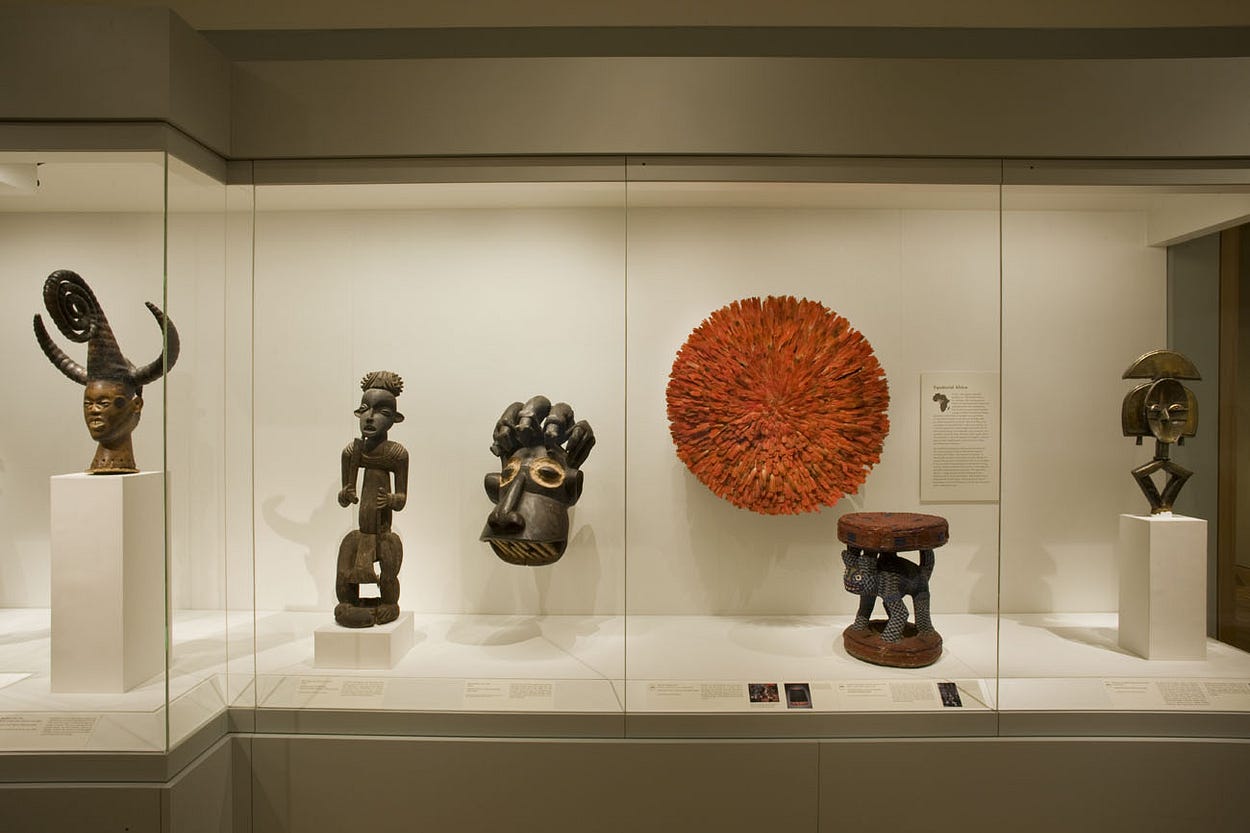
Empathy is an essential trait to navigate this world; it is a complex, abstract concept that can be difficult to practice. This has led to my research and reflection, compiled into a brief field guide of empathy for the art museum that can help visitors engage with the unfamiliar and learn through uncertainty. It would be irresponsible on my part to approach objects within the African arts galleries without any research or references, but with these steps, the act of viewing can be broken down into something that enriches the experience and our awareness.
Techniques for Empathetic Thought
Look
Dr. Kristen Windmuller-Luna, CMA’s curator of African art, offers instructions on how to begin looking at unfamiliar works within the African galleries,
“Come in with an open mind and not have the fear of doing something wrong,” she suggests. “Know that there is opportunity to learn and be open to it. First, be open to the beauty and the artistry and appreciating that artistry and have that be your first step. Really, I’d say start with looking.” With this, she implies, you don’t need to be an expert to appreciate the works.
Let’s take a moment to follow her guidance and become acquainted with this Nok head. Begin by simply making written, or mental, notes of your observation and record what you see. Focus on what is in front of you and brush aside any bias that might interfere. Don’t rush. Consider all the visible details: color, texture, materia, shape, size, lines, surfaces and more.
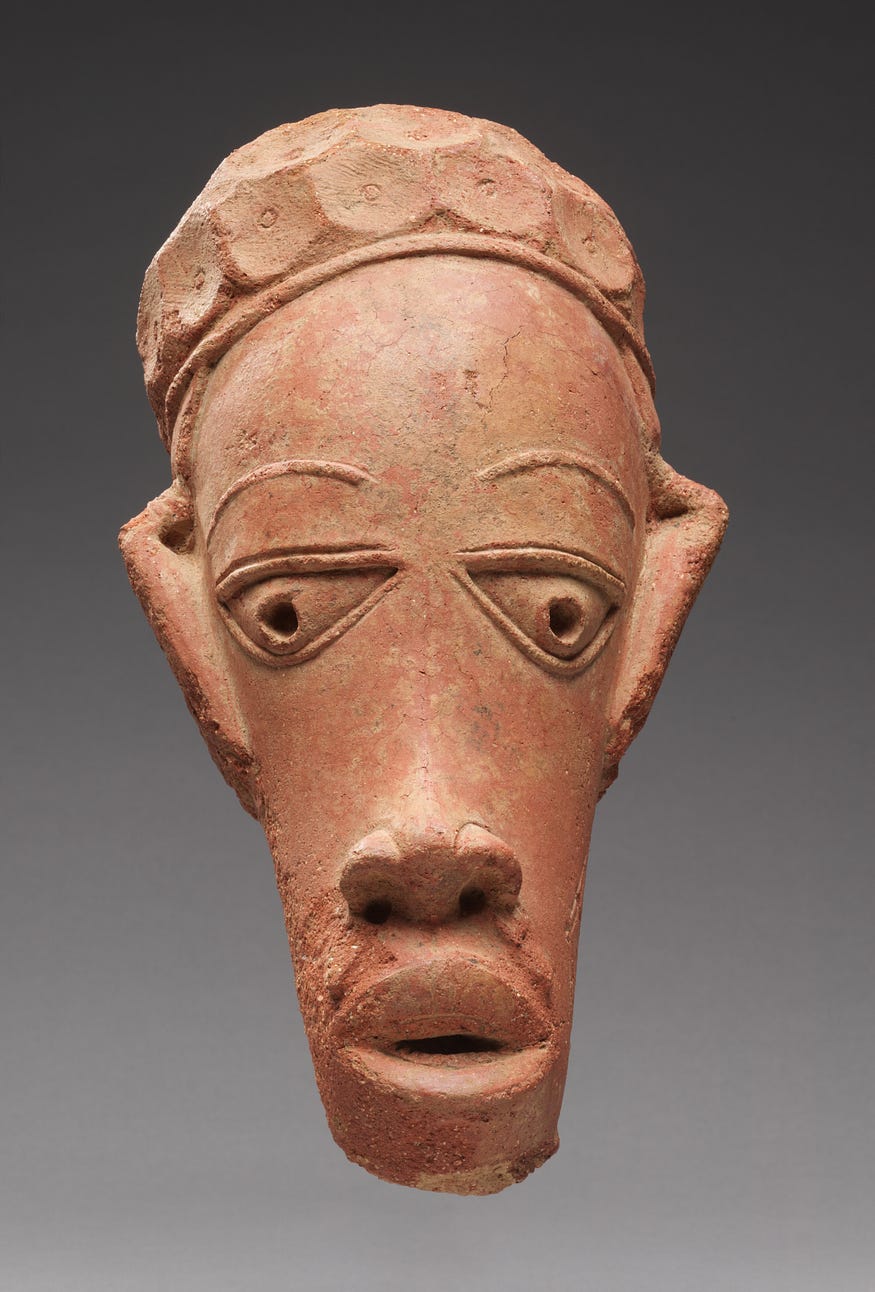
Describe what it might feel like to touch or hold this object. Is it smooth? Is it heavy? Then research, read, and understand in what context it lived before a museum. Once we have looked, Windmuller-Luna encourages us to keep going. “You have just started analyzing something historically; you are on the right path, and then you fill in the blanks. Then you start to look at the label.”
The legacy of the Nok culture (opens in a new tab) style is difficult to determine due to the mystery around their identity and origins. We know they were one of the earliest known societies in West Africa, having lived in modern-day Nigeria, from around 500 B.C. to AD 200. Nok artistry influenced the beautiful metalwork of its people, who later lived in Nigeria — an inspiration that continues today. This head’s intentionally asymmetrical and striking features come together in a still and careful expression, which is a prime example of this influential Nok culture style.
More than a foot high, this terracotta head possibly belonged to a life-size sculpture of a seated male, perhaps a notable leader. In its entirety, it most likely lived in a shrine, temple, or tomb. Another possibility is that it was created to honor ancestors and communicate between worlds.
Reflect
Another way to understand artworks is through reflection. What was your initial reaction to this piece? Why did you feel that way? Reflect on your references and the assumptions you hold.
Consider what is familiar to you. Have you seen something like this before? Where did you see it and what about it reminds you of it now? It is crucial to be critical of your references. What is your frame of reference? Is it accurate? To answer these questions, take time to ponder, reflect, and find new details.
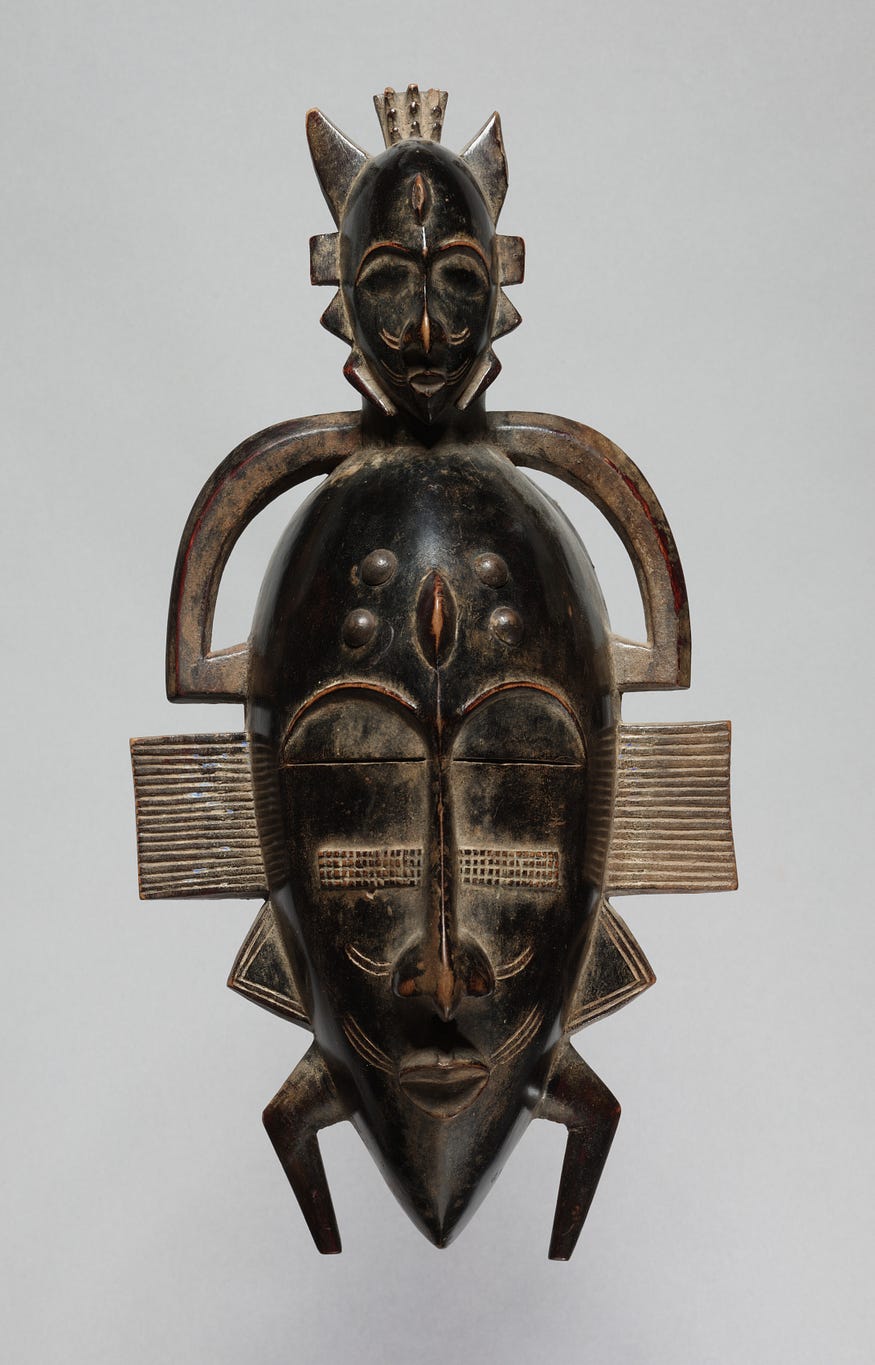
A mask like this one originates in West Africa. It is attributed to the artist Sabariko Koné, and before coming to the museum in 1989 it was reportedly owned by James Freeman, a collector in Kyoto, Japan. It is specifically associated with the poro (opens in a new tab) secret society, formed as early as 1000 and still functional today. It is worn in various coming-of-age ceremonies, reserved only for men who went on to govern the people in this society. When I look at face of this mask, I see characteristics of a feminine beauty: the scars allude to female genitalia, and therefore fertility, and the resin surface suggests that of smooth, oiled skin, a sign of female beauty.
Kayleigh Bryant-Greenwell (opens in a new tab), a cultural equity strategist and museum educator of the Empathetic Museum (opens in a new tab), discussed first impressions and her understanding of the CMA’s Face Mask. She spent time looking at this artwork, and I provided some historical context. We did not read the label right away. She said, “I grew up around African masks and this kind of iconography with my grandparents on my dad’s side. As far as studies and a deep knowledge base go, most of my interaction with African masks in adulthood are through the artworks of David Driskell (opens in a new tab) and Romare Bearden (opens in a new tab)— African American modernists — as well as Aaron Douglas (opens in a new tab). And so in that sense it looks familiar to me.”
We all bring our own references with us to a gallery: identify and acknowledge any preconceived notions you bring to the museum and reflect on them.
Mindfully Participate
These objects may have lived through traumatic times in which they were stolen from their intended place, purpose, and cultural heritage, passed through strangers’ hands, and placed in front of us. We coexist with them in the gallery and should consider how they came to be behind the glass. We cannot be ignorant of the living nature of objects in a gallery, nor can we be ignorant of our part in it. We can dismiss or misconstrue these works as simply objects, or we can take time to respect them by giving attention to their purpose and story.
When I asked how we can approach an artwork without historical references, Dr. Matthew Rarey (opens in a new tab), Oberlin College art historian of Africa and the Black Atlantic world, said that each object lives a life of its own.
“The object exists independent of what the artist brought to it. And it takes on new lives and new contexts, and part of these new lives is what everyone who sees and interacts with brings to it, and adds to it, and it accumulates new meaning. So, one half is historical, and one half is pedagogical.”
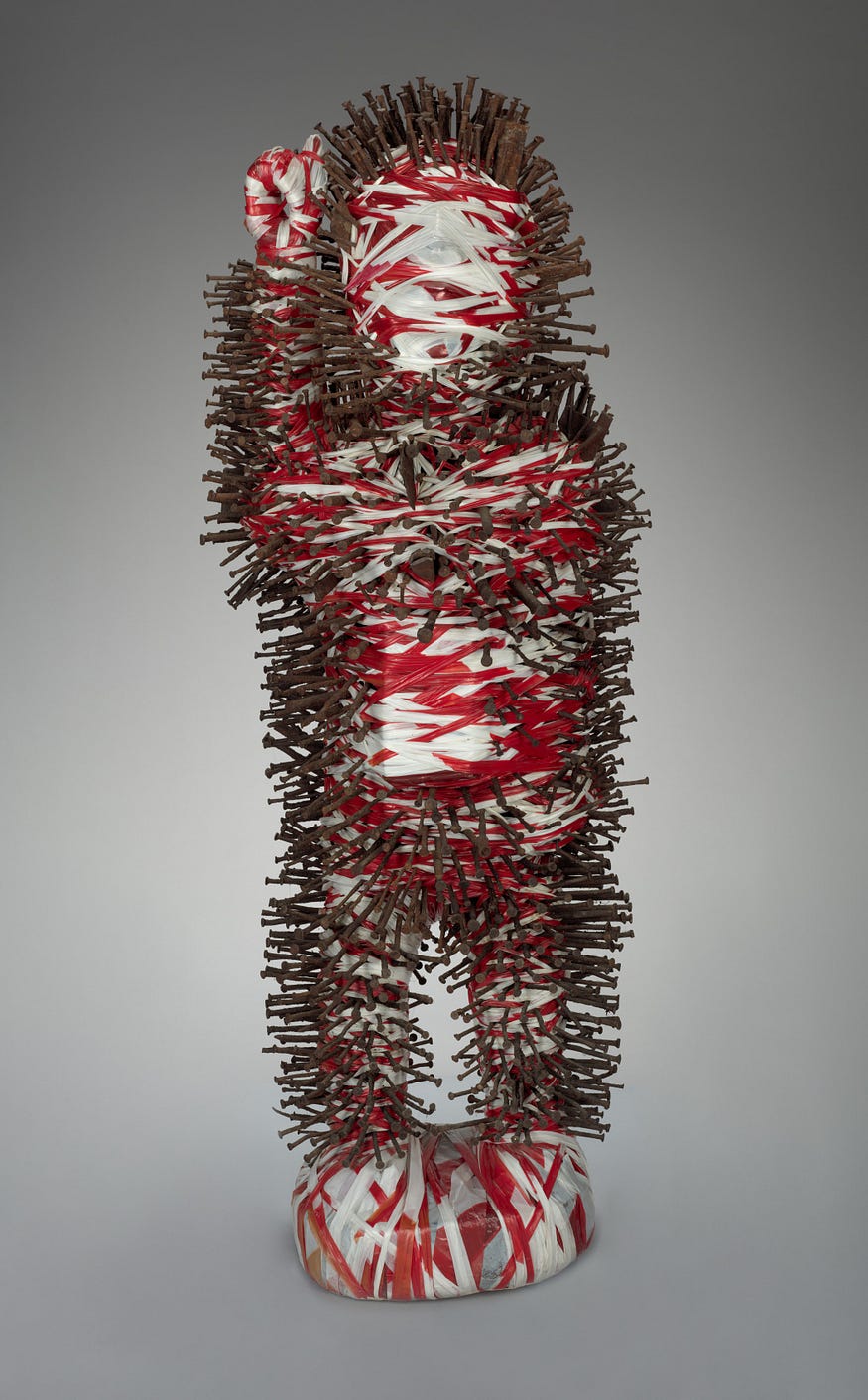
Kendell Geers (opens in a new tab)’s work here is a contemporary homage to nkisi nkondi (opens in a new tab) figures of the Kongo Kingdom, objects that contain activating substances that connect the world of spiritual and ancestral forces. Each nail reflects a time that the nkisi was used or activated by the ritual specialist. The red and white tape completely covers this figure, face and all, but the nails are sticking out, creating a stark visual tension between old and new. Although appearing fierce, these were figures of covenant and community. A nkisi builds goodwill and creates positive social contracts by physically and ritually keeping the memory of the moment of agreement. For every social contract or promise, families and communities have had a nail driven into the nkisi. The activated object would hold accountable these agreements among the community.
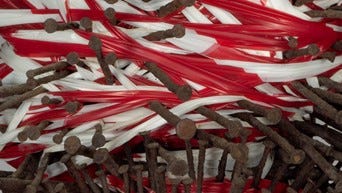
This contemporary piece from 2005 varies from traditional minkisi (plural of nkisi) in that it wasn’t made for ritualistic purposes. I notice the distribution of protruding nails that are evenly placed, strategic, and which hold symbolic meaning. Made by a South African artist, I find it interesting that he used red and white tape, which in South Africa is equivalent to the yellow and black caution tape used in America. By considering these details while viewing Geers’s work, we are participating in its current museum existence by challening our assumptions of artwork found in an African art gallery.
When discussing the significance of a contemporary piece in the African collection, Dr. Underwood explained that we cannot see Africa as an ancient or static place in our world. “So the image of Africa that is presented to a layperson who knows nothing and just walks in is that Africa is all in the past,” he said. “There’s nothing about Africa that is right now. . . . Putting [a contemporary work] in there is a way of disrupting the idea of Africa as something in the past.”
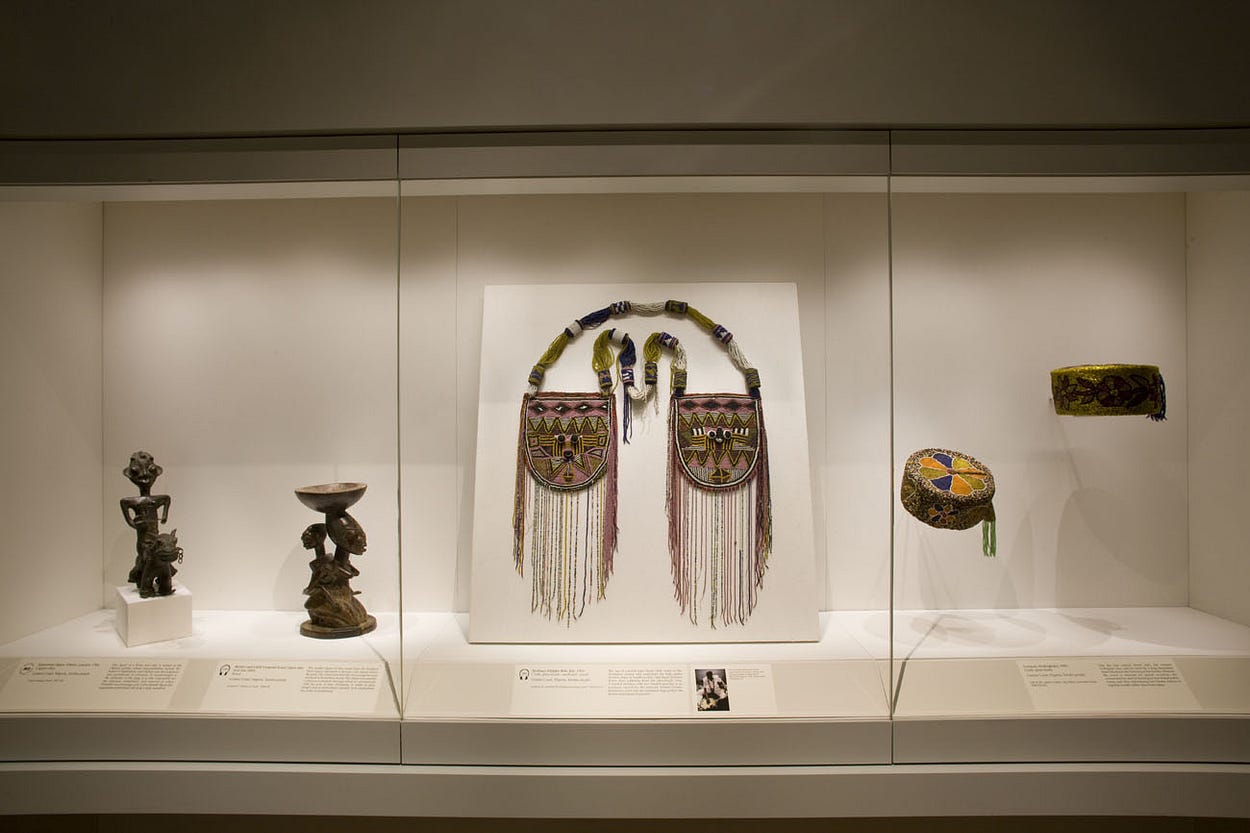
Learning how to be empathic is a process, not a one-time achievement. To begin the journey, we need to examine our personal biases and how they affect our sensory, emotional, and intellectual reactions to artworks. Few visitors can expect to have a complete historical knowledge of all the art they experience, but we cannot make the mistake of dismissing what is unfamiliar as not valuable.
The essence of this guide is to encourage visitors to slow down, look, reflect, and be mindful within African arts galleries — and others — that contain objects that seem unfamiliar. I must remind myself of these steps, as I am also sometimes quick to dismiss what I do not understand. Moving through these concepts and learning about an artwork’s historical context will help provide a well-rounded experience, giving attention to crucial histories that may have initially been overlooked.
[1] Joseph Underwood, “No One Told Me: A Gap,” Doppiozero. March 30, 2016, https://www.doppiozero.com/materiali/why-africa/no-one-told-me-gap